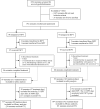Heliotherapy for neonates with severe-to-hazardous hyperbilirubinemia: a randomized controlled, non-inferiority trial
- PMID: 39465350
- PMCID: PMC11514263
- DOI: 10.1038/s41598-024-77085-3
Heliotherapy for neonates with severe-to-hazardous hyperbilirubinemia: a randomized controlled, non-inferiority trial
Abstract
Filtered-sunlight phototherapy (FSPT) that blocks ultraviolet light and reduces infrared radiation is safe and non-inferior to intensive electric phototherapy (IEPT) for treating mild-to-severe neonatal hyperbilirubinemia. In this randomized non-inferiority trial, the safety, efficacy, exchange transfusion (ET), and mortality rates of FSPT versus IEPT among Nigerian neonates with severe-to-hazardous hyperbilirubinemia were investigated. Safety was defined as the absence of hyperthermia, hypothermia, dehydration, or sunburn; efficacy by the proportion of assessable treatment days during which total serum or plasma bilirubin (TSB) increased by < 0.2 mg/dL/hr for newborns aged ≤ 72 h-old or decreased for newborns > 72 h-old. A treatment day was deemed assessable if a neonate received phototherapy for ≥ 4 h, and non-inferiority was inferred for differences within a 10% margin. We enrolled 192 newborns (admission TSB ≤ 62 mg/dL), assigned to FSPT (n = 98) or IEPT (n = 94). FSPT was effective on 94.2% of the assessable treatment days compared with 97.1% for IEPT. The mean difference in efficacy between FSPT and IEPT was -2.9%, 95% CI: -7.6, 1.9). 2.6% of newborns who received FSPT developed controlled hyperthermia, and no baby met the criteria for withdrawal for safety reasons. Overall, 50.6% (39/77) of newborns who received FSPT and 53.7% (51/95) of newborns who received IEPT had ET (p = 0.89) and 7 in each group (9.1% vs 7.4%; p = 0.86) died. In conclusion, FSPT is safe and non-inferior to IEPT for treating neonates with severe-to-hazardous hyperbilirubinemia, it is not associated with significantly higher rates of ET and mortality and should be considered where practicable when IEPT cannot be assured. Clinical Trials.gov Number: NCT02612727 (24/11/2015).
Keywords: Acute bilirubin encephalopathy (ABE); Bilirubin-induced neurologic dysfunction (BIND); Exchange transfusion; Filtered sunlight phototherapy; Glucose-6-phosphate dehydrogenase (G6PD); Hazardous hyperbilirubinemia; Intensive phototherapy; Low- and middle-income countries; Neonatal mortality; Severe hyperbilirubinemia.
© 2024. The Author(s).
Conflict of interest statement
The authors declare no competing interests.
Figures
References
-
- Olusanya, B. O., Kaplan, M. & Hansen, T. W. R. Neonatal hyperbilirubinemia: a global perspective. Lancet Child Adolesc. Health.2(8), 610–620 (2018). - PubMed
-
- National Institute for Health and Care Excellence. Neonatal jaundice: clinical guideline 98. https://www.nice.org.uk/guidance/cg98 (accessed 23 April 2024). (2010). - PubMed
-
- Olusanya, B. O., Teeple, S. & Kassebaum, N. J. The contribution of neonatal jaundice to global child mortality: findings from the GBD 2016 Study. Pediatrics141(2), e20171471 (2018). - PubMed
Publication types
MeSH terms
Substances
Associated data
Grants and funding
LinkOut - more resources
Full Text Sources
Medical
Miscellaneous




